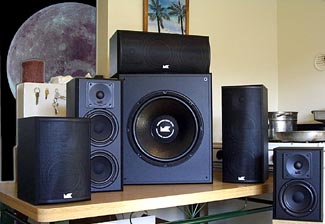Product Review - M&K THX Select 5.1 Loudspeaker System - July, 1999 Colin Miller
|
M&K THX Select System- LCR-750THX Front Speakers,
Center 750THX Center Speaker, S-550THX Surround Speakers, and V-1250 12" Powered
Subwoofer Manufacturer's Specifications: LCR-750THX, Center 750THX, 16 1/16" H x 7" W x 8 3/4" D, Weight 16 lbs. S-550THX 10 1/4" H x 7" W 8 3/4" D, Weight 9 lbs. Recommended amplifier power, 20-200 watts. FR 80-20,000 Hz � 3dB V-1250THX 18" H x 15 1/4" W x 23" D, Weight 44 lbs, Amplifier rated at 125 watts. In-Room FR 20 Hz - 80 Hz. MSRP: LCR-750THX $675/pair black, $775 gloss black. Center 750THX $335/each black, $385 gloss black; S-550 THX $540/pair black, $640 gloss black. V-1250THX $850/each black, $950 gloss black. |
| Miller & Kreisel Sound Corporation; E-Mail [email protected]; ; Web http://www.mksound.com. |
Introduction
THX has split into two consumer groups. What was THX became THX Ultra, making room for THX Select. Lucasfilm developed THX Select not only to cater to smaller listening environments than THX Ultra does, but to also provide the assurance of THX certification with more affordable products. Is M&K�s THX Select 5.1 system, retailing for a little more than $2,000, affordable? While I do consider two grand a significant sum, in the world of high-performance loudspeakers, it's on the less expensive side.
THX Ultra and THX Select have more in common than a licensed logo. THX Ultra specifies virtually identical left, center, and right speakers with a flat on-axis frequency response. So does THX Select. THX Ultra requires a wide and even horizontal dispersion to cover a large listening area with consistent tonal character. So does THX Select. THX Ultra systems must play loud with relatively little distortion. THX Select systems must play almost as loud in the same manner.
All in all, there are really only a couple of differences that I can discern. While Ultra requires limited vertical dispersion of high frequencies for the left, center, and right speakers in order to minimize the reflections from the floor and ceiling that may become quite problematic for maintaining focused sonic images in larger rooms, Select allows more conventional "point source" radiation in that regard. Since people usually sit closer to the speakers in smaller rooms, they occupy more of a "near-field" position. That is, the listener receives a greater proportion of direct sound with any given dispersion pattern, and so benefits less from the limited vertical dispersion that Ultra offers. On the other hand, with a more uniform vertical dispersion pattern, the person may then listen standing up or lying down without seriously suffering for it.
Ultra also mandates dipolar surround speakers, placed to the side, with drivers firing forward and backward, out of phase (while one cone is moving out of the box, the other cone is moving inward). If the magnitude from both sides is equal and opposite, it creates a null in the direction of the listeners. Hence, the listener hears no direct sound, but does hear the majority of the reflected sound from all directions. Lucasfilm chose dipolar radiation for the Ultra spec since it most easily simulated a large array of surround speakers in a very large venue, such as a commercial movie theater.
However, in smaller environments, especially those which have the rear wall very close to the listening position, dipolar speakers don�t work as well as they should. The sound reflected from the rear wall not only causes an imbalance of output between the front and rear of the dipolar speaker, lessening the null, but sends a large proportion of the surround sound to the front of the room, which may reflect back to the listener from the wrong direction and collapse the surround envelopment. The surround speakers can't simply be moved forward, away from the wall, because if the listening position isn't in the null, the surround speakers become directional again, and what's worse, in front of the listeners.
To address this, THX Select allows wide-dispersion unidirectional surround channels. Unless undergoing 7.1 enhancement, the surround speakers should nestle more to the side of the listening area, but still a little behind it. In the case of the rear wall, they may be aimed slightly above the listening area, sliding much of the surround information off the wall at an angle slight enough to create a sense of envelopment. For many of us who do not have large, dedicated, ideal listening rooms, this is a godsend. THX Select, welcome home.
I wasn�t an early THX adopter, being a hard-core music-oriented audiophile, but the original THX system, in appropriate situations, reaped very real benefits that indirectly coerced much of the high-end industry to take notice: accurate tonal rendition, harmonic integrity, extreme dynamic capabilities, and a larger optimum listening area. Everybody hears the dialog and sound effects in proportion, while the sonic images consistently and continuously follow the visual ones. As much as I admired the thought that went into the original THX, it didn�t fit my personal needs. THX Select, however, makes more sense for my small living room, and my habit of occasionally listening to music while fixing dinner in the kitchen (standing).
The right stuff
M&K�s THX Select system, comprised of the LCR-750THXs, Center-750THX, S-550THXs and V-1250THX components, is among the first of a new breed. That isn�t very surprising, considering that M&K pioneered the development of a system for the original THX standard, now designated THX Ultra. Neither was that fact itself surprising, since M&K has supported the subwoofer satellite concept adopted by THX long before the explosion of home theater. Perhaps less coincidentally, M&K�s involvement in the recording industry has taken the professional world by storm. Dolby Labs and Skywalker Ranch, both key figures in cinematic audio reproduction, have adopted M&K speakers as reference monitors, and the following grows for good reason. A friend of mine deep in the professional industry commented once, after having borrowed a pair of M&K satellites and a subwoofer for a two-channel application, that they were an absolute pleasure to mix with. The term "amazing" came up, twice. To this day, after three years, they�re still on his mixing console, and his buddies are taking notice.
Ironically, when I first heard M&K satellites, they had already been paid for. I picked up a brochure at a dealer, and swayed by the lack of baloney, decided to give them a try. They didn�t initially "blow me away," so to speak. I heard a lot more detail than most speakers, but also noticed a thin, analytical nature, as well as a slight squeaky edginess. Even though I had received a good deal on a demo pair, my spirits drooped. I didn�t know it at the time, but it was all my fault. In a more colorful analogy, I had just tried to race a Ducatti street bike on a tank of vegetable oil across a mud bog while towing a trailer while intoxicated. In other words, I didn't have the right equipment upstream.
Many speakers are designed to sound "better" than accurate in order to make the best first impression. They may add excessive warmth in the midrange, or zing in the treble with the typical variations of the "smile-curve" response. I've even come across some popular models that intentionally create a notch filter by crossing the midrange over lower than the tweeter, dipping output in the upper midrange and effecting a smooth character that shifts attention to the extra treble "detail" (greater relative output). I've heard some speakers that costs many thousands of dollars which made me wonder if the midrange driver was even connected! Some speakers, to convince the listener of "deadly accuracy", let a very stiff midrange run up too high in terms of frequency and into the diaphragm's breakup region, causing a presence peak along with nasty distortion, causing an artificial "in your face" kind of exactness that just about rips the ears off the skull before the salesman explains how "revealing" and "quick" they are.
M&K satellites are truly such. They�re not designed to produce frequencies much below 80 Hz, but rather, concentrate their efforts upwards. They don't really have much bass, and they don't try to fake it by bumping up what they do have to offer. Nor do they take it easy with unqualified equipment, intentionally enhance sonic qualities, or to be quite frank, give a hoot what you or I think. They are an expression of practical steps toward an accurate portrayal of the signal that went into the microphone. Sometimes what went in isn't particularly impressive or mind-boggling. Could I really hold a speaker responsible for compensating for everything around it? Unless a person is VERY aware about all the circumstances of the entire situation, it's hard not to.
At the time of first introduction, I had no subwoofer, ran a modestly powered receiver full-range (without an active crossover) into an impedance that dipped below 4 Ohms, expecting the warm yet tilted character I had come to know from "high-end" mini-monitors like entry-level Celestion or KEF models that I had seen at the local chain store. I almost gave up on M&K products then, but I�m very glad that I didn�t. Suffice it to say, be warned. I have a small bit of history with M&K products, so I may not remain as impartial as I should. One might argue, though, that an impartial reviewer has simply failed to complete the tasks preceding.
M&K�s THX Select system resembles their less expensive LCR-55/V-75 system that impressed me about a year ago, except these are bigger, better, and specifically designed to fit the THX paradigm. The subwoofer incorporates a fixed 80 Hz, 4th order Linkwitz/Riley low-pass filter, providing a bypass switch that allows a THX processor to do the same thing. THX processors will also implement an 80 Hz, 2nd order Butterworth high-pass filter. The satellites coincidentally roll off at about 80 Hz as well, similar to a 2nd order Butterworth filter. Cascading the two roll-offs results in a 4th order Linkwitz/Riley high-pass curve, and Voila! The result sums flat. Somebody behind THX is pretty clever.
Why all the emphasis on crossovers?
Why an 80 Hz, 4th order Linkwitz/Riley filter alignment? Crossovers are not inherently superior to each other, but simply feature different performance aspects that engineers must utilize to maximum advantage. Most audiophiles agree that as the crossover frequency increases, it becomes harder to blend the subwoofer with the satellite, be it a small speaker with no bass, or a full-range speaker with response below 30 Hz. At the same time, as the crossover frequency increases, distortion from the satellite decreases, the total dynamic range increases, and loading the room for the flattest response becomes much easier. The logic of the 80 Hz crossover point is that it�s high enough to ease demands on the speakers and amplifier, but low enough to make the whole shebang work without a tremendous headache. The 4th order (24dB/octave roll-off, 6dB/octave/pole) Linkwitz/Riley alignment not only offers a steep slope, but one that immediately transitions to that slope, maximizing the benefits of that slope near the crossover point. The high-pass side minimizes excursion and power requirements, while the low-pass minimizes more localizable content at higher frequencies. M&K builds on this by attenuating anything after the 4th order L/R filter above 125 Hz at 36dB/octave, cutting off stray dialog at the throat.
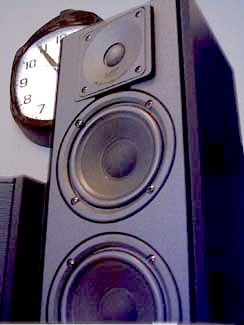 There are some catches. To properly blend the subwoofer with the satellite for a
flat response across the transition, the high pass electronic filter and the roll-off of
the satellite speaker must both sum as a 4th order Linkwitz/Riley filter.
Because of this, the electronic high-pass filter must be an 80 Hz, 2nd order
(12dB/octave) Butterworth alignment, and the satellite speaker must have an
identical response. However, many speakers are intentionally designed for extension
below 80 Hz, which screws up the final high-pass curve. Many speakers also employ
ports or passive radiators, whose response then rolls off too quickly (at 24 dB/octave),
screwing up the high-pass curve even more. Therefore, although many speakers may
work marginally well when thrown into the loop with a THX processor, the proper implementation
of a THX system requires satellites based on a sealed system with an 80 Hz �3
dB low
frequency cutoff, preferably with a Qtc of 0.71 (I will put together an
article on what all these terms mean soon).
There are some catches. To properly blend the subwoofer with the satellite for a
flat response across the transition, the high pass electronic filter and the roll-off of
the satellite speaker must both sum as a 4th order Linkwitz/Riley filter.
Because of this, the electronic high-pass filter must be an 80 Hz, 2nd order
(12dB/octave) Butterworth alignment, and the satellite speaker must have an
identical response. However, many speakers are intentionally designed for extension
below 80 Hz, which screws up the final high-pass curve. Many speakers also employ
ports or passive radiators, whose response then rolls off too quickly (at 24 dB/octave),
screwing up the high-pass curve even more. Therefore, although many speakers may
work marginally well when thrown into the loop with a THX processor, the proper implementation
of a THX system requires satellites based on a sealed system with an 80 Hz �3
dB low
frequency cutoff, preferably with a Qtc of 0.71 (I will put together an
article on what all these terms mean soon).
Another pitfall of the THX crossover system is that because of the quick transition from subwoofer to satellite, and the fact that 80 Hz lies in a slightly more sensitive range of human hearing, compared to a full octave down at 40 Hz, the successful integration requires more stringent level-matching. This, in turn, limits the common practice of using the subwoofer as a low frequency tone control. You may get a couple of dB up and down to dial the bass level in to taste, but many listeners typically have the subwoofer 8 -10 dB higher for dramatic effect. That may do with more gradual crossover curves having 40 - 50 Hz points, but at 80 Hz, the sudden shift in frequency response will call attention to itself, generating an irritating boom.
"I�m a subwoofer, over HERE!"
On top of that, raising the subwoofer level too high brings the high frequency content that the crossover attenuated up as well, without raising the output of the satellites one bit. Hence the subwoofer begins to challenge the output of the satellites that should contribute the vast majority of information in that frequency range, generating confusing localization cues. The whole point of this tangent is that the THX subwoofer/satellite crossover arrangement requires deliberate steps to set up properly, and everything must be correct to make it work. THX processors don't just put a test tone into the setup to make your room shake. If you want to do THX correctly, get an SPL meter or a spectrum analyzer and truly match levels, then crank it two or three decibels if you want. If you need a real bass boost to serve up the goodies the way you like 'em, and want to do it with a THX system, check out a good EQ. AudioControl and Rane both make excellent ones that meet THX certification.
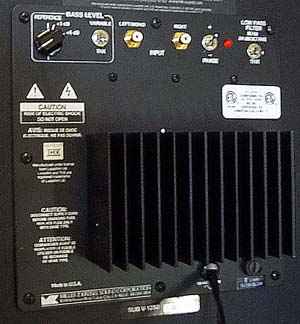 The power behind the
pounding of the V-1250THX stems from an amplifier rated at 125 watts, combined with a
Headroom Maximizer circuit to prevent overdriving both the 12" woofer and the
amplifier. Like any speaker manufacturer, M&K claims a long-throw woofer, which means
higher linear excursion than typical, but everything is relative. I didn�t take the
initiative to rip the driver apart and measure the coil and gap height in order to figure
out the linear excursion of the driver, but pushing on it and looking at the suspension
implies something pretty decent. The cabinet is not diminutive, but neither unreasonably
large. Also included are volume control, fixed/variable volume toggle switch, phase
reversal switch, and two line-level inputs.
The power behind the
pounding of the V-1250THX stems from an amplifier rated at 125 watts, combined with a
Headroom Maximizer circuit to prevent overdriving both the 12" woofer and the
amplifier. Like any speaker manufacturer, M&K claims a long-throw woofer, which means
higher linear excursion than typical, but everything is relative. I didn�t take the
initiative to rip the driver apart and measure the coil and gap height in order to figure
out the linear excursion of the driver, but pushing on it and looking at the suspension
implies something pretty decent. The cabinet is not diminutive, but neither unreasonably
large. Also included are volume control, fixed/variable volume toggle switch, phase
reversal switch, and two line-level inputs.
The LCR-750THX, Center 750-THX, and S-550THX satellites look like conventional two-way designs for the most part. M&K calls the crossover Phase-Focused. Phase-Focused refers not simply to the crossover itself, but how that crossover reacts with the driver response, and the driver dispersion characteristics. What this means in standard English is that M&K takes great pains not only to achieve a flat response on-axis, but off-axis as well, in both horizontal and vertical planes through lots and lots of measurements from different locations, lots and lots of listening, and lots and lots of tweaking. I think you can see now why good speakers are not just a matter of using good drivers, but using good drivers in carefully designed configurations. This takes lots of work, and that is why good speakers cost good money.
A point of interest with the 750s, including the center channel, is that the mid-bass and tweeters are aligned in a MMT (mid/mid/tweeter) array as opposed to the more common MTM configuration inherent to many center channels. MTM arrays place the mid-bass drivers, which often run up to 2-3 kHz, on opposite sides of the tweeter and hence relatively far away from each other. This results in a greater arrival delay off-axis, as one driver is significantly closer to the listener than the other, and hence severe comb filtering. I once attended a THX training seminar on acoustics, and to quote John Dahl, who addressed MTM center channels while conducting the class, "This sucks." An MTM arrangement does look more symmetrical and hence aesthetically appealing, but it creates, forgive the pun, an upper mid-range suck-out for listeners who can�t sit directly in front of the center channel. It also introduces an imbalance in reflected sound for the listener on-axis. The MMT method is a simple arrangement that alleviates the problem without compromising performance or adding cost.
The mid-bass drivers used in this system are essentially the same as the LCR-55s, and for that matter, the LCR-75s (reviewed by David Moretti in Secrets). The S-550THX surround speakers use identical tweeters and mid-bass drivers as the LCR-750THX and Center 750THX speakers, but with only a single mid-bass. Like the LCR-75s, the LCR-750THX front speakers and Center 750THX use two mid-bass drivers, not only doubling power handling, but doubling efficiency compared to a single driver, resulting in a four-fold gain in terms of possible dynamic range. Even if extreme volume levels aren�t required, dynamic range and efficiency in a loudspeaker system is a very good thing, as it implies less dynamic compression at moderately high listening levels.
Perhaps the most unusual feature of the speakers is the tweeter. It�s not odd in itself, a rather conventional but high-performance soft-dome unit used in all of M&K�s current products, including their flagship 5000THX system and ultra-high performance S-1C monitors. The weird thing is that each tweeter is tilted. By mounting the tweeters tilted 4.5 degrees off-axis, the angle compensates for the effects of the perforated metal grille. The resulting response is optimized for on-axis listening, and off-axis away from the side the tweeters angle toward. If you don�t catch that in the manual, the speakers have written instructions on the back, arrows indicating how they should sit in relation to the screen.
One might point out that removing the grilles instead would prove more practical. However, the metal grilles do provide a performance advantage by minimizing little finger, claw, and peanut butter infraction artifacts. Given that the speakers are already built, and designed to function as is, it makes sense sonically, and I think cosmetically, to leave the grilles on.
In order to get a more objective handle on how demanding these speakers really are with amplifiers, I ran an impedance sweep from 20 Hz - 20,000 Hz for both the LCR and surround models.
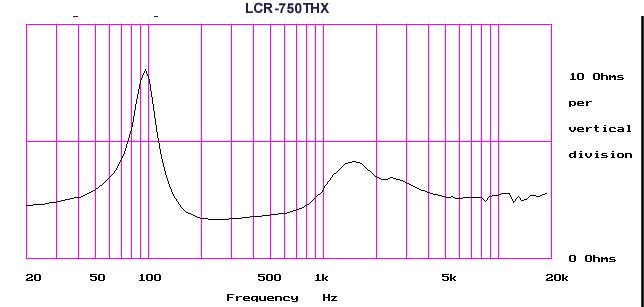 |
A look at the impedance curve of the LCR-750THX shows a shallow valley between 150 Hz and 600 Hz where the load drops below 4 Ohms, reaching a minimum of 3.3 ohms at roughly 250 Hz. Though better receivers can cope with this, cheap one�s won�t. Dedicated power amplifiers for the front three channels may be a good idea in any case.
A look at the S-550THX surround speaker shows a relatively benign load, dropping to 6.8 ohm minimum in the same manner. I asked Charles Back at M&K about this, and he mentioned that THX Select actually specifies surround speakers with an 8 Ohm nominal impedance to make life easier on receivers. This suggests that a user could not only hope to reasonably drive a system to usable levels with a good receiver, but also supplement a system with a three-channel amplifier, allowing any decent receiver to power the rear channels famously.
I brought the entire system over to a friend�s house, who had just that arrangement (a Yamaha RX-V995 supported by a B&K TX-4430 3-channel amp), and it worked very well indeed. I had tried letting the RX-V995 take on the full system, and it wasn�t bad, but I think that the extra outboard help definitely paid off in fuller, less strained performance. And, if somebody wanted to take the route of entirely outboard power amplification, as I did (8008BB & 8008X3), go ahead. These speakers can eat up power like baby birds munching at a grubfest.
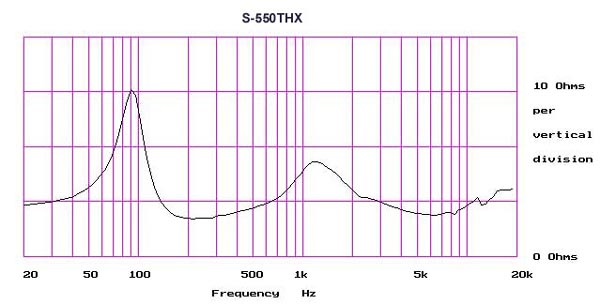 |
During listening at home, I mounted the rear speakers about 7 feet up and to the side as described for the situation of a couch against a rear wall. Left, Center and Right speakers were all about the same height, approximately 3 � feet high at the tweeter, evenly spaced with about 45 degrees separating the left and right speakers. The subwoofer had to come a few feet out of the left corner to properly lock with the residence dimensions, as the corner location caused some really annoying cancellations in the middle of the room, and shook the rest of the house to spite me. As always, experimentation is key to setup.
I listened to the Alan Parsons DTS CD first. It was interesting, nifty, and kind of neat, but not particularly enlightening. I threw "A Bug�s Life" and "Armageddon" into the DVD player, and man, that was fun. Never painful, never soliciting, but exciting as hell. Still, not obnoxious. No bloated boom or stinging zaps, but a shot of adrenaline heaven just the same. Even then, I still wondered how far these speakers could go with a slightly better processor. The RX-V995 (review forthcoming) does a pretty good job for the $1,000 price tag, but I wouldn�t have minded if Stacey L. Spears just happened to drop by to show off his Meridian 861. The Acurus ACT-3 is certainly welcome to come back and demonstrate its new bass management features anytime it wants as well. Come to think of it, what's Denon doing these days. Am I fishing? Always.
It should be noted that the Yamaha RX-V995 uses a non-THX crossover alignment (90 Hz, 3rd Order filter Low-pass, 90 Hz 2nd order filter for the high-pass), and that although it worked fairly well when bypassing the internal subwoofer crossover, the proper alignment will allow a better transition and a more "invisible" subwoofer. If a user wishes to integrate a receiver or processor with a non-THX type crossover, s/he should run the left/right outputs full-range, split that output with an M&K passive HP-80 high-pass filter (12 dB/octave at 80 Hz), and use the internal crossover in the subwoofer.
Put into a two-channel application for music CDs, the M&Ks did extraordinarily well once pulled into the room away from nearby walls. With tricky studio mixes, the LCR-750THXs went nuts. Dire Straits� "On Every Street" album sounded almost as clear and sweet as when I first heard it with some full-range Audio Static ESLs, but with a more extended top-end, and far more precise localization. Chris Issak�s "Heart Shaped World" had a couple of tracks that sounded even visually present, enveloping, and dimensional, even if the result of artificial reverb and other studio tricks. Mars Lasar�s "Eleventh Hour" album hurled a stage that made me wonder if I was feeling fear or giddiness. Geez, I heard insects coming out of my walls! I turned my head to look, and it just kept coming. I�m not only impressed, I�m stamped. Pulling out a Sony 20 bit remaster sample (downsampled with Super Bit Mapping) of Dave Brubeck�s "Take 5" let the drum solo's percussive skins and tins romp and splash across and back through the room while my eyes followed, hunting for the source. Properly dialed into the room, the speakers don�t even seem to be on.
To really put dynamics to the test, I had to visit the romantic era. The LCR-750THX satellites and the V-1250THX sub had no qualms digging into Tschaikovsky�s "Romeo & Juliet," contrasting the savage, supple, and sensitive without shifting gears. Bass grabbed enough floor to smack the gut, but not cause dizziness. Treble felt neither smoothed over or accented, and the mid-range reminded me why I really hate those smile-curve speakers. Slam factor? Who wants some? Many have stated that speakers designed for home theater aren�t good for music, and vise-versa. I think that�s a bunch of (insert colorful explicative) hooey.
Compared to my long-term companions, the Infinity Renaissance 90s, one of that company�s last serious efforts in the very competitive hard-core audio market, I found the M&Ks depressingly good. I love my Infinitys. Though every speaker has different strengths and weaknesses, I haven�t found a full-range speaker under $4,000 yet that I�d trade them for. And yet, these inexpensive little satellites were nipping the heels of the established rulers of my realm. I did prefer the smoothness and spaciousness in the lowest frequencies that the Ren 90s excel at, complemented with a mid-bass tight as ceramic coffee mug, and a mid-range and treble as clear as the view between the moon and mars. However, had I two V-1250THX subs, the bass may have smoothed out a wee bit, and there�s no reason anyone can�t spring for an extra sub if they choose. Two subs are ALWAYS better than one of the same. The 750s were just slightly warmer, overall extremely clear, never dull or veiled, and actually a little more accommodating with most recordings than the ruthless 90s. Moreover, even though the Infinity�s Planar Ribbon tweeter did have a little more ambiance in the very highest regions (16 kHz - 20 kHz), I thought the treble of the 750s perhaps a little more natural, and certainly more even-tempered off-axis, though it pains me to admit so. Aural images in space traversed about the room, detached and free to meander with both the Infinitys and the M&Ks. However, the M&Ks could lock down and bring forward various items on the menu slightly better than the Infinitys. On the other hand, the Infinitys had an advantage conveying the immense.
The Ren 90s gobble power like gluttons, and tear up amplifiers to boot, but the M&Ks, armed with a high-pass filter, retained just a bit more composure nearing obscene volume levels. I suspect that this may have to do with using exclusively air-core inductors in M&K products as opposed to iron-core inductors in the Ren 90s and many other speakers. Iron-core inductors usually have better efficiency (less resistance), but they can also saturate, becoming non-linear at high output levels. It might also be that the high-pass filter put the amplifiers more at ease, lowering voltage requirements as well as current draw. Regardless, what can squeeze through a couple of tiny 5" mid-bass drivers freed of deep bass widens the eyes.
I�m not tossing my Ren 90s by any means, but the M&Ks did get me thinking, pulling my chair closer to the negotiating table. As the audio industry is heavily subjective when it comes to reviewers, I�d be shocked if nobody else thought some other similarly priced 5.1 loudspeaker system a superior benchmark of value. This is mine. Bottom line text byte: real fidelity, real cheap.
They ain't going back.
Colin Miller
Components used during this review:
Aragon 8008BB Power Amplifier
Sunfire Stereo Power Amplifier
Yamaha RX-V995 Receiver
M&K THX-Select Loudspeaker System
Infinity Renaissance 90 Loudspeakers
JVC XL-Z1050 CD Player
Pioneer DV-414 DVD Player
Audio Control C-101SE EQ
Bybee/Curl Prototype AC Purifiers & Power Cords
M'Dor Power Cord
DH Labs Silver Sonic Interconnects
AudioQuest Diamond Interconnects
Liberty Emerald 14-4 Speaker cable, custom-terminated..
![]()
� Copyright 1999 Secrets of Home Theater & High
Fidelity
Return to Table of Contents for this Issue.

